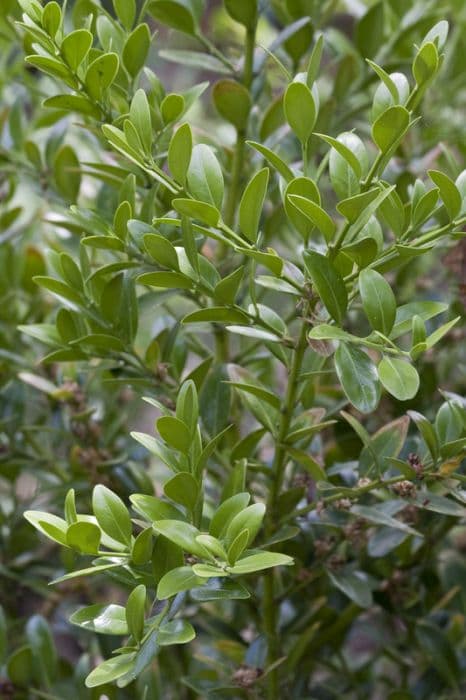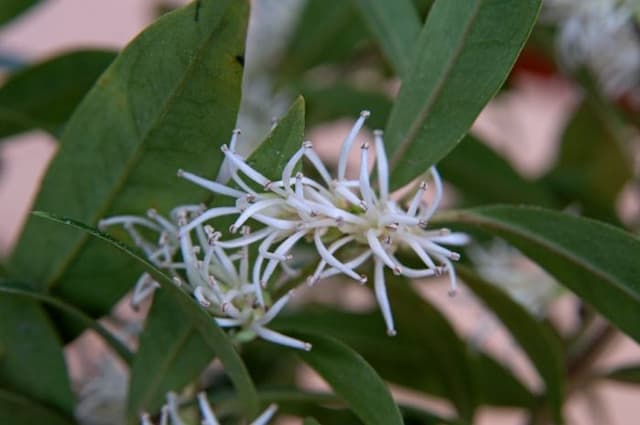Sweet Box Sarcococca ruscifolia var. chinensis

ABOUT
Commonly known as Sweet Box, this evergreen shrub is notable for its glossy, leathery, and dark green leaves that are arranged alternately on the stems. The leaves typically have a pointed tip and a smooth margin. During the winter months, Sweet Box produces small, white, highly fragrant flowers that emerge from the axils of the leaves. These flowers are followed by glossy, blackberry-like fruits when the flowering season is over. The overall form of the plant is compact and bushy, with a dense growth habit that makes it ideal for use as a ground cover or as part of a mixed border in a garden setting. The rich visual texture and the sweet scent of its blooms make Sweet Box a desirable plant in many landscapes.
About this plant
 Names
NamesFamily
Buxaceae
Synonyms
Chinese Sweet Box, Christmas Box, Sweet Box
Common names
Sarcococca ruscifolia var. chinensis.
 Toxicity
ToxicityTo humans
Sweet Box, while not considered highly toxic to humans, may cause adverse reactions if ingested. This could include symptoms such as nausea, vomiting, and diarrhea. It is advisable to avoid consuming any part of this plant to prevent these potential negative consequences.
To pets
Sweet Box is also not well-documented as being severely toxic to pets. However, it is generally recommended to prevent pets from ingesting plants that are not part of their normal diet. If a pet does consume Sweet Box, they may experience mild gastrointestinal upset, including vomiting and diarrhea. Always monitor your pet's health and consult with a veterinarian if you suspect they have ingested any part of this plant.
 Characteristics
CharacteristicsLife cycle
Perennials
Foliage type
Evergreen
Color of leaves
Green
Flower color
White
Height
2-3 feet (0.6-0.9 meters)
Spread
1-2 feet (0.3-0.6 meters)
Plant type
Shrub
Hardiness zones
7
Native area
China
Benefits
 General Benefits
General Benefits- Ornamental Value: Sarcococca ruscifolia var. chinensis, commonly known as Sweet Box, is valued for its glossy evergreen foliage and neat habit, which make it an attractive addition to gardens year-round.
- Fragrant Flowers: The plant produces small but highly fragrant flowers that can add a pleasant scent to gardens, particularly noticeable during late winter.
- Shade Tolerance: Sweet Box is particularly suited for shaded areas where many other plants may struggle to thrive, making it useful for underplanting and dark corners.
- Low Maintenance: This plant requires minimal care once established; it is drought-tolerant and generally free from major pests and diseases.
- Ground Cover: With its dense growth habit, Sweet Box can be used effectively as ground cover, preventing weeds from establishing and minimizing soil erosion.
- Wildlife Support: The flowers provide nectar for pollinators such as bees early in the year when few other nectar sources are available.
- Berries for Birds: After flowering, it produces berries that can provide a food source for birds during autumn and winter months.
- Winter Interest: Sweet Box offers garden interest in winter with its evergreen leaves and berries when most other plants are dormant.
- Edging and Borders: Its compact form makes it ideal for edging and border planting, providing structure and greenery all year round.
- Tolerates Pollution: This plant can tolerate urban pollution, making it a suitable choice for city gardens and landscaping near roads and buildings.
 Medical Properties
Medical PropertiesThis plant is not used for medical purposes.
 Air-purifying Qualities
Air-purifying QualitiesThis plant is not specifically known for air purifying qualities.
 Other Uses
Other Uses- Sweet Box can be utilized as a natural dye source for fabrics, imparting subtle colors derived from its leaves and stems.
- The wood of Sweet Box is sometimes used for small carvings and crafting decorative items, capitalizing on its hardness and fine grain.
- The dense foliage of Sweet Box is often used in topiary gardens, as it lends itself well to precise shaping and maintains its form throughout the year.
- Rather than for visual aesthetics, Sweet Box is sometimes incorporated into sensory gardens, where the focus is on fragrance and texture, enhancing the sensory experience.
- Due to its resilient nature, Sweet Box can be used in erosion control, especially on slopes or in areas requiring stabilizing vegetation.
- Sweet Box is applicable in creating natural outdoor mazes or labyrinth designs as it can be easily trimmed to maintain the structured pathways.
- Some cultures may use branches and leaves of Sweet Box as a natural insect repellent, though it's not as widely recognized for this purpose.
- In floral arrangements, cut stems of Sweet Box bring not only greenery but also a pleasant fragrance to indoor spaces, lasting longer than many other cut greens.
- The dense, evergreen nature of Sweet Box provides excellent ground cover under larger trees where other plants might struggle due to lack of light.
- For filmmakers or photographers, Sweet Box, with its rich green foliage and small, star-shaped flowers, can be used to create evocative and moody forest floor scenes.
Interesting Facts
 Feng Shui
Feng ShuiThe Chinese Sweet Box is not used in Feng Shui practice.
 Zodiac Sign Compitability
Zodiac Sign CompitabilityThe Chinese Sweet Box is not used in astrology practice.
 Plant Symbolism
Plant Symbolism- Protection: Sarcococca, commonly known as Sweet Box, is often associated with protection due to its dense evergreen foliage, which creates a protective barrier in gardens year-round.
- Purity: The white flowers of Sweet Box emit a pure, sweet fragrance, which can symbolize innocence and purity.
- Perseverance: Sweet Box thrives in shade and less-than-ideal soil conditions, representing the ability to persevere through challenging circumstances.
- Hidden Beauty: The flowers of Sweet Box are small and not immediately noticeable, symbolizing the idea that beauty is not always obvious and may be hidden beneath the surface.
- Resilience: With its ability to withstand shade and colder temperatures, Sweet Box symbolizes resilience and the capacity to withstand adversity.
 Water
WaterThe Sweet Box prefers consistent moisture but dislikes waterlogged soil. Water the plant thoroughly when the top inch of soil feels dry to the touch, which typically means once every week or two, depending on climate conditions. Use about 1 gallon of water for each watering session to ensure the root zone is well-hydrated. During hot, dry spells, you might need to water more frequently to maintain moisture levels, but always check the soil moisture before adding more water. In winter, reduce the frequency of watering as the plant's growth slows down and it requires less moisture.
 Light
LightSweet Box thrives best in partial to full shade, making it a suitable plant for a shaded garden spot or beneath the canopy of larger trees. It can tolerate some morning sun but should be protected from strong afternoon sunlight to prevent leaf scorch. An ideal location would provide dappled sunlight or light shade throughout the day, mimicking its natural understory habitat.
 Temperature
TemperatureSweet Box is hardy and can withstand temperatures as low as 0°F, making it suitable for a variety of climates. The ideal temperature range for optimal growth is between 60°F and 80°F. It is not suited for extremely hot climates where temperatures regularly exceed 90°F, as excessive heat can stress the plant.
 Pruning
PruningPrune Sweet Box to maintain its shape and remove any dead or diseased growth, enhancing the plant's overall health and appearance. Light pruning can be done anytime during the year, but the best time for heavier pruning is in late winter or early spring before new growth begins. Typically, pruning is done annually or as needed to keep the desired form.
 Cleaning
CleaningAs needed
 Soil
SoilChinese Sweet Box prefers well-draining soil with rich organic matter. The best soil mix for this plant would be a mixture of loam, peat, and perlite or sand to ensure good drainage, along with a pH range of 5.5 to 6.5, slightly acidic.
 Repotting
RepottingThe Chinese Sweet Box should be repotted every 2 to 3 years to refresh the soil and to accommodate its growing root system. Spring is the ideal time for repotting this plant, before new growth begins.
 Humidity & Misting
Humidity & MistingChinese Sweet Box thrives in moderate to high humidity levels. Aim for a humidity level around 40-60% for optimal growth, making sure the environment is not too dry.
 Suitable locations
Suitable locationsIndoor
Keep in bright, indirect light and water when top soil is dry.
Outdoor
Plant in partial shade, sheltered from harsh sun and wind.
Hardiness zone
7-9 USDA
 Life cycle
Life cycleSarcococca ruscifolia var. chinensis, commonly known as Chinese sweet box, starts its life cycle as a seed, often germinating in the spring following dispersal by birds who eat the berries. Upon germination, the seed develops a root system and a shoot that grows upwards, evolving into a seedling with characteristic glossy evergreen leaves. As a young plant, it establishes itself, gradually forming a dense, bushy shrub with multiple stems. During its mature stage, Chinese sweet box flowers in late winter to early spring, producing small, fragrant, creamy-white flowers that are followed by red berries that mature to black. The plant reaches reproductive maturity within a few years, continuing to flower and produce berries annually, contributing to the spread of the species. This evergreen maintains a steady state of vegetative growth and seasonal flowering until eventual senescence, after many years, leading to a decline in vitality and productivity.
 Propogation
PropogationPropogation time
Early spring
For Sweet Box (Sarcococca ruscifolia var. chinensis), the most popular method of propagation is by semi-ripe cuttings. This technique is best done in late summer. Cuttings of about 4 to 6 inches (10 to 15 cm) long are taken from the current year's growth. The lower leaves are removed, and the cut end can be dipped in rooting hormone for better results. The cutting is then planted in a pot with a mix of peat and perlite or sand to provide good drainage and aeration. The pot should be kept in a warm, humid environment out of direct sunlight, ensuring the soil remains moist but not soggy. Roots usually develop within several weeks, at which point the new plant can slowly acclimate to normal conditions before being planted out in the garden the following spring.






![Sweet box [Winter Gem]](/_next/image?url=https%3A%2F%2Fplants-admin.emdemapps.com%2Fimages%2Fplants%2F%2Fimages%2F604b6267b442c.png&w=640&q=75)


